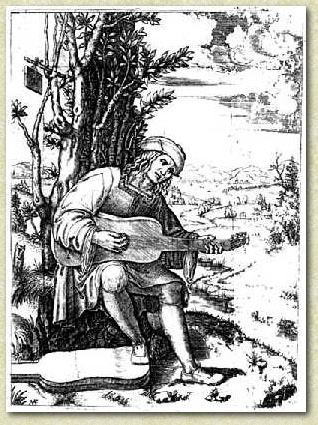THE VIOLA OR VIHUELA

The design based on a painting by Juan de Juanes [1523-79] La Trinidad con querubines y ángeles in the Convento de Santa Clara, Gandia (Valencia).
The earliest references to the viola or vihuela
come from XV century sources, through paintings and engravings in books. Before
the XVI century the terms: guitarra, chitarra,
guiterne or gittern referred to a tiny treble lute, which
in the XVI century became known as the cetere
or cittern.
Chitarrino or chitarino was a small
four course guitar which later in the XV Ic. became known as small
treble lute. Viola
meant a small guitar like instrument tuned the same as the six course lute
of the XVI century. with a seventh string added in the bass tuned to E. This
instrument described in a XVc. manuscript was called viola
de mano in Italy. There
is no essential difference between the viola de mano and
its Spanish equivalent the vihuela de mano.
Important source on instruments:
Juan Bermudo "Declaración de Instrumentos
Musicales" published in Osuna (1555).
To study musical forms:
Howard Meyers, "Music of the Renaissance"
Most important study: John Milton's PHD dissertation, "La
Vihuela de Mano"
CITERN
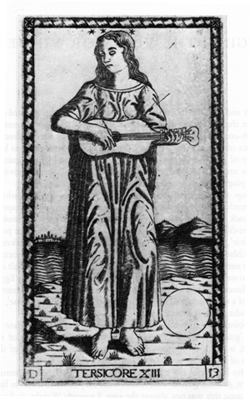 |
The strings of this instrument go over the bridge to the bottom of the instrument, like those found in metal string instruments. The fret system is made of small wooden block frets that can be re arranged for different tone and semitones combinations. The body shape is also found on other citterns of later dates like the mandora. The Medieval Gittern
and Citole: Lawrence Wright |
SPAIN IN THE 1500'S
Naples and Sicily were part of the Spanish speaking possessions of the House of Aragón. Naples was connected to the Papal Court of Rome and to the famous courts of Ferrara, Urbino and Mantua, the centers of artistic life in Europe at the time. There was great musical activity in Ferrara where musicians such as Leonardo del Chitarino and the most important lute player of the century Pietro Bono del Chitarrino (who played lute cittern and viola de mano), served under Duke Leonello d'Este.
Prince Ferrnando de Aragon married Isabella d'Este of Ferrara and Mantua, who was the daughter of Elonora de Aragon and grand daughter of King Ferrante of Naples. She was the most influential royal patron of the arts at the time. When Isabella became queen of Castile in 1474 and Ferdinand became King of Aragon in 1479, almost all of Spain came together under their rule. The total unification of Spain was completed in 1512 with the conquest of the Kingdom of Navarre.
The Court of Don Fernando de Aragon, Duke of Calbria in Valencia, c.1526-c.1550; music, letters and meetings of cultures by Bernadette Nelson. Early Music May 2004.
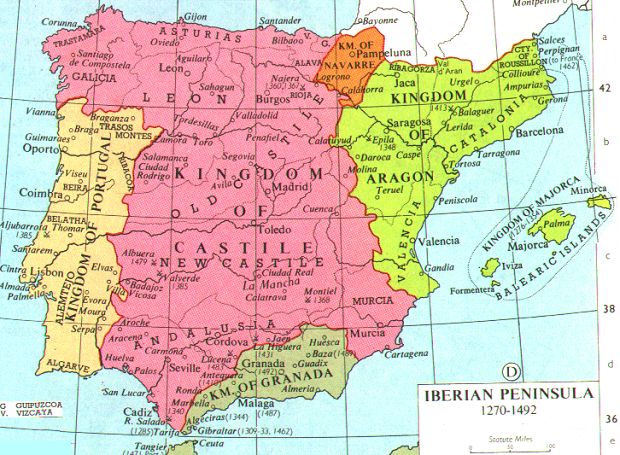
ITALY IN THE 1500'S

Although the evidence so far appears to suggest that the Iberian vihuela usually had a flat back and peg box with probably unison stringing of the bass courses, whilst the Italian viola da mano had a curved, vaulted back and a sickle-shaped peg box, with octave stringing of the basses (like the contemporary 6-course Lute), considerably more research needs to be done to define these two schools of construction and playing with any certainty - especially since the Chambure vihuela has both a vaulted back and a flat peg box, both features being absolutely original to each other. The modern type vihuelas used in the Mexican mariachi ensemble follow the style of the Chambure vihuela, with the vaulted back but with modern tuning machine heads.
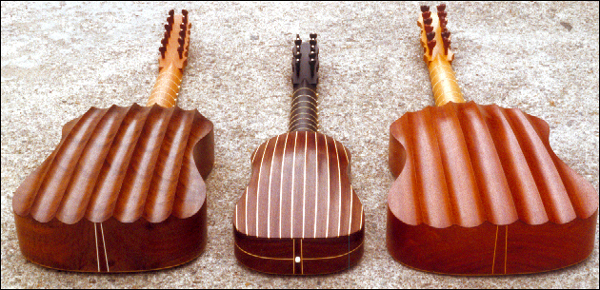
The image above shows (on the left) the first of our 'Evolution' versions of the Chambure vihuela, with our first copy of the Chambure on the right; a version of the related Belchior Dias guitar is in the center.Stephen Barber & Sandi Harris
The collections of music for vihuela in Spain are:
Luys Milan - El
Maestro (1536)
(the first book of instrumental music known to have been printed in
Spain)
Alonso de Mudarra- Tres libros
de música en cifra para vihuela c.(1546,
Seville)
Miguel de Fuenllana- Libro
de música para vihuela, intitulado Orphenica Lira (1554,
Valladolid)
Mudarra and Fuenllana include pieces for four string
guitar also.
Luys de Narváez- Los
Seis libros del Delphin de música
en cifra para tañer la vihuela.(1538,
Valladolid)
Enriquez de Valderrábano- Silva de Sirenas (1547, Villadolid)
Diego Pisador-
Libro de música de vihuela (1552, Salamanca)
Esteban Daza- El Parnasso
appeared in Valladolid in 1576 as the last collection of vihuela music.
NOTE: In the 1970's, Pepe Rey announced the existence of a new book for vihuela tablature, El Ramillete de Flores, and in recent years John Griffiths has studied a new source of pieces intabulated for the vihuela: the manuscript Ms. Mus. 40032. Among the composers found in these collections are Luys Maymón and Francisco Paéz
The Spanish Vihuela page by Juan Carlos Ayala Ruiz
Italy
|
Engraving by Marcantonio Raimondi, after a portrait by Franceso Francia.
|
The first edition of lute music in Venice by Petrucci in 1509, gives rules for playing from Italian tablature. These rules are repeated with slight modifications in practically every lute book published up to 1520. Francesco Canova da Milano (1497-1543)"Intabolatura de viola overo lauto.....1536 in the Italian style, for lute (6 course) or viola de mano. Vihuela music can legitimately used by the lute since the tunings for lute and for vihuela are the same (the lute at this time used octave pairs at the lower three courses). Both instruments share repertoire with the same stylistic norms, and technique . No vihuelist specifies specific pitches for tuning but one can find good instructions in Juan Bermudo's book "Declaracion de Instrumentos Musicales". The poet Giovanni Filoteo Achillini ( Bologna, 1146-1533) playing a five course viola de mano. Performance on Lute, Guitar
and Vihuela Edited
|
Milan's Tablature

There is something unique about Milan's tablature: all other vihuela books use Italian tablature.
Italian tablature uses numbers to represent frets, and the bottom line represents the the highest sounding string. French tablature uses uses letters instead, and the highest pitch is represented by the top line of the tablature.
Milan merges French and Italian tablatures, with Italian numbers, but the top line representing the highest course of the vihuela. The only other sources with similar notation come from places under the Kingdom of Aragon: Catalonia, Naples, Sicily and Sardinia.
Frencesco da Milano also uses the top line of the tablature to represent the highest course, but this Neopolitan system uses the number 1 to designate the open string.
http://sologuitarist.net/tablature.htm
Sixteenth-Century Printed Tablatures for the Lute, Guitar, and Vihuela: An Annotated Bibliography. Compiled by Dr. Gary R. Boye Music Librarian, Appalachian State University
Vihuela in g'- based on the instrument in the Musée Jacquemart-Andrée, Paris
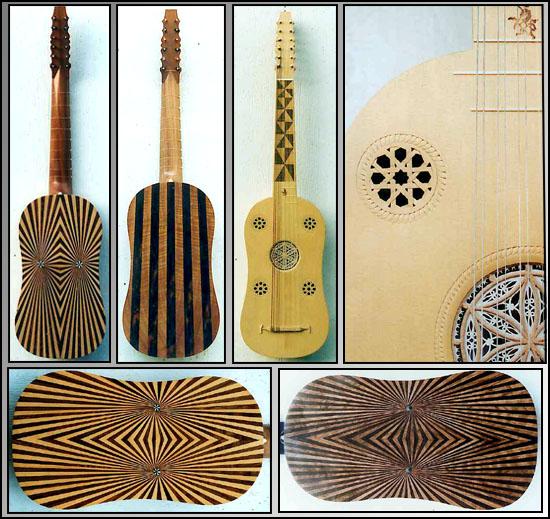
Vihuela Technique and Musical Indications
|
Terminology a. Instructions are seldom given on how to hold the instrument, we infer that c rests on the soundboard by the art from those times. b. Technique is much like that of the lute. c. Redobles-
scales passages. f. Diminutions
and glosas (ornamentation) when intabulating a text, where only
used in cadential points.
|
g. Compás-
means measure in modern Spanish, but in the Renaissance
it had two meanings: a measure of music, and tactus-
a constant unit of time-pulse or beat.
Milan defines compás as an even ascending and descending movement of either the hand or foot. This is the usual notion of tactus, as described by the physical gesture that conveys it. Compás equals the semibreve (whole note with diamond shape), except in instances of compás mayor, where it equals a breve (two whole notes). When there is no time signature at the beginning of the piece in El Maestro-which is almost always the case--the Compás is ¢ with the beat equaling a whole note (diamond shape). |
"Luis Milan on Sixteenth-Century Performance Practice" by Luis Gásser. Indianna University Press.
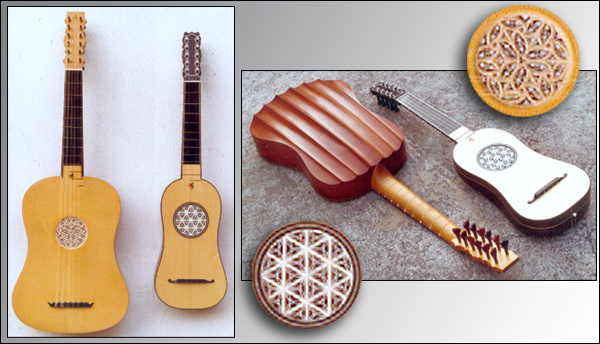
The image above shows the relative sizes of the Chambure vihuela
and the Belchior Dias guitar of 1581.
| Music in Vihuela Books Spanish books contain mostly instrumental pieces and dances are relatively rare, Mudarra's Galliard is the only one in his book. The most important musical forms are: Fantasias- Redobles and Consonances: a relatively free composition with one or several themes. Tiento: like a ricercare or fantasia. Diferencias: earliest examples, Narvaez, Conde Claros, with the fundamental element of the chord progression. Pavanas and Songs-Villancico and Romance.
|
© 2006 Patricia A. Dixon
